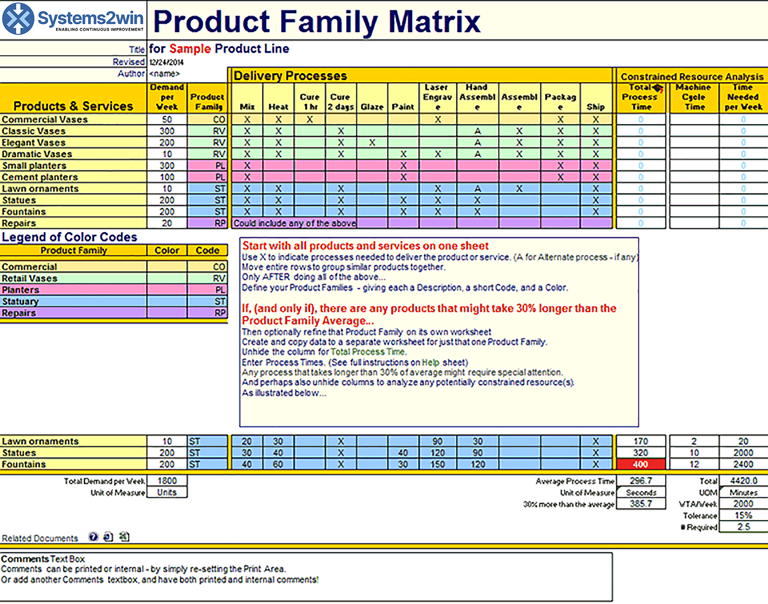Installation and Setup
Installation - Each User. Installation - Multi-user. Language Translations. Personalize Your Templates.Systems2win Training.
Quick Start Initial Training. New User Training. Training Matrix. Systems2win Leadership. Training Classes.Lean Training
Lean Training and Coaching. Lean Principles. Muda 8 Wastes. Goal - Lean Flow. Roadmap - Lean Journey. Value Stream Mapping. Standard Work. Hansei Lean Thinking. Lean Dictionary. Online Lean Training. Lean Leadership.Microsoft Office Training
Excel Training. Excel Drawings (without Visio). Excel Charts. Word Training. PDF Training. Document Storage and Naming.Support
Support.Product Family Matrix
aka Product Quantity Product Rounding PQPR Matrix
Why use a Product Family Matrix?
If your organization offers any products or services that have low volume and high variety, then the single most important lean technique for dealing with high variability is...
to segment your products into the right product families
And why is this so useful for low volume, high mix?
to maximize lean flow, so that you can then manage the total demand for the entire product family
Total demand for a product family is much more predictable and manageable than demand for each individual product or service.
It's not an overstatement to say that lean management for low volume high mix is simply not possible without well-considered product families.
That's what your Product Family Matrix template does for you.

Sample Product Family Matrix example
When to use your
Product Family Matrix
You define your product families as one of the first steps in the Value Stream Mapping phase of a Typical Lean Journey.

Road map for a typical
Lean Transformation
How to use your
Product Family template
Find and open your template
Find and open your Value Stream Mapping Product Family Matrix template
(vsmProductFamily.xlsx)
in the same way that you find and open your other 150+ Systems2win templates.

Save your working document
following the usual document storage and naming conventions established by your leaders
Open a Blank Sheet
When you're ready to start doing your own real work...
click the button to 'Open a Blank Sheet'
Excel Ribbon > Systems2win tab > Open a Blank Sheet
This blank sheet is where you will do your real work
(not on the Sample sheet — which gives you sample data that is extremely helpful for learning how to use your new tool, but is the wrong place to do your real work)

Rename your new sheet.
If English is not your preferred language
Switch to your language, just like every Systems2win Excel template.
Now your team is ready to start using your
Product Family Matrix template
to divide your offerings into manageable product or service families
Start with all products and services on one sheet
Tip: You might use two separate worksheets to define your product families from a Marketing perspective and an Operations perspective (which can be very different).
Value Stream Mapping is concerned only with the Operations perspective.
List all of your products and/or services in the rows
Be sure to include less obvious "products," like prototypes, production of molds or tools, samples, etc.
Be sure to include the services that you deliver — not just products.
List your processes in the columns
In addition to processes and machines, you can also use additional columns for any other factors that differentiate your product lines (from an Operations perspective).
For example, perhaps some products have similar seasonal demand, or similar shelf life, or use the same hazardous materials, requirement for a sterile environment, etc.
Perhaps use a code or cell format to identify processes that go through a shared work center,
because when grouping similar products together, you are often looking for opportunities to group together processes that might soon be routed through equipment dedicated only to that product family.
For each process used to deliver a product or service, mark the cell with an X
You can also identify possible Alternate processes with an A.
(Or A1, A2 if there are multiple alternate possibilities)
Move rows to group similar products together
Move entire rows or columns
Right-click & drag entire row or column > Shift Down & Move
Excel training video
Add, Copy, or Move rows
Get consensus about what a product family means in your company
Usually, a product family consists of only products and services that are similar enough to be treated as a single product for scheduling purposes.
Learn more about High Mix Value Streams
Define your Product Families
Only AFTER you have done all of the above…
Define the Legend for your Product Families
giving each a Description, a short Code, and a Color.

Usually... that's it... you're done
Your Product Families are now very obviously and visually defined
Optional: Refine Each Product Family
If (and only if)...
there is any product that might take 30% longer than the Product Family average…
then...
Create a separate worksheet for just that one Product Family
If you copy the existing worksheet as a starting point for the new one...
use the special utility: Systems2win menu > Copy Sheet

Enter Process Times
Unhide the column for 'Total Process Time'
Assign and train team members to gather time observation data.
Deal with lengthy processes
Any process that takes longer than 30% of average might require special attention to identify any offerings that take so much more time to produce that they might need to be either moved to another product family or be scheduled using special techniques
See online training for High Mix Value Streams
Optionally analyze any potentially-constrained resources
Unhide the columns for 'Constrained Resource Analysis'
to determine resource requirements
(for equipment or any other potentially-constrained resource)
Tip: You can copy these columns for as many resources as you need to analyze.

The Product Family Matrix template comes with many other useful Value Stream Mapping tools
to empower every team member to improve every process
New User Training
Your Systems2win templates come with free New User Training
to quickly learn features that are common to all 150+ templates
Support
One huge benefit of owning your Systems2win templates is Support when you need it

Why are we paying our people to re-invent tools, training, and systems that can be owned so easily?
Own Yours Now
This Product Family Matrix
comes with many other useful Value Stream Mapping tools
Training and Coaching
Consider Training and Coaching to support your teams to succeed

Training to get you started.
Tools you won't outgrow.
Schedule a Conference
Schedule a conference
to discuss your challenges
with an experienced lean advisor
Download Trial Now
Get a dozen trial templates,
and another dozen free gifts
@@@ Better conversion rate
if call to action is for a specific tool, and shows the image

Try It
Try this template
along with a couple dozen more
process improvement tools
Calls to Action Botttom
Related Topics
Related Topics section WITHOUT TESTIMONIALS
Replace this paragraph with menu library item for topics related to this video
Training and Coaching
Consider Training and Coaching to support your teams to succeed

Training to get you started.
Tools you won't outgrow.
Schedule a Conference
Schedule a conference
to discuss your challenges
with an experienced lean advisor



























